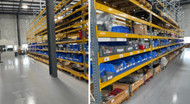If you’ve ever managed a warehouse, you know the floor is more than just concrete under your feet. It’s where forklifts race, pallets get dropped, chemicals spill and dust gathers. Over time, even the toughest slabs start to look tired, cracked, stained, and hard to clean.
Traditionally, fixing that means heavy floor preparation, grinding, patching, and basically turning your warehouse into a construction site. It’s not only noisy, dusty and slow, but it’s expensive as well. This is where no floor prep and a 3-layer warehouse coating system transform the floor without mechanical surface preparation.
In this post, we’ll break down how that kind of system works, what the layers usually include and when it actually makes sense to use a no-prep solution.
Why Warehouse Floors Are Tough to Renovate
There is no doubt that warehouses are difficult to maintain and the floor suffers from heavy machinery to heavy foot traffic. Warehouse often have to face constant traffic that impact and vibrates all day. Many floors already have paint, epoxy glue or tile adhesive bonded to the surface, which makes it hard to cover.
With these challenges, 3 layer floor coating helps to create a suitable foundation for the warehouse. The standard industrial coating systems usually require,
Intense surface prep with grinding and shot blasting roughen the surface while priming and other coats like epoxy can damage the floor. With all the prep on flooring, the process of renovation is slow and disruptive. This is the main issue that no floor prep systems address.
What 'No Floor Prep' Really Means
No floor prep doesn’t mean you can just pour resin over dust and walk away. In practice, it usually means,
- No heavy mechanical prep like grinding or shot blasting over the entire area.
- Minimal cleaning and localised repairs instead of full resurfacing.
- Use a chemical engineer primer to bond the surface or tolerate minor contaminants to create bridge for new system.
You still need to:
- Sweep and vacuum.
- Degrease obvious oil spots.
- Remove anything loose or flaking.
- Fix major cracks or holes.
The benefit here is to skip the loud, dusty and slow mechanical prep over the entire floor and go straight into coating after basic cleaning.
Step by Step Guide on 3 Layer Warehouse Coating System
A 3-layer coating system typically works in the same manner as other systems, but the difference stands in the 'no prep' category. Below is the step by step guide to apply 3 Layer system.
Layer 1: No Prep Primer- The Bonding Bridge
Make the new floor system stick securely to the old, imperfect surface. Typically, this stage includes
- Clean the floor to make sure all dust and loose debris is thoroughly vacuumed.
- Spot-clean heavy oil or grease patches.
- Apply the no-prep primer using roller or squeegees.
- Allow it to cure according to the manufacturer’s instructions.
Once cured, this layer becomes the anchor for the rest of the layers to sit on.
Layer 2: Building Coat-Strength and Thickness
Add durability, impact resistance and even out the appearance. This usually implies a high-build epoxy or thicker than regular paint to create a robust wear layer. You have to make sure that
- Resin and hardener are mixed thoroughly.
- Pour and spread using a squeegee then back roll.
- Optionally broadcast flakes or aggregate if slip resistance or a decorative look is desired.
Allow it to cure fully before the final layer.
Layer 3 Topcoat-Protection, gloss and clean
This final coating is protect the system and make the floor easy to live with. The topcoat is often a polyurethane or polyaspartic coating. UV resistant and scratch free. To apply this coat, it is necessary to
- Lightly inspect the build coat for defects, fix anything obvious.
- Mix and roll the topcoat in controlled sections
- Let it cure, often faster than epoxy, which means you can return to use relatively quickly.
Final thoughts
Renovating a warehouse floor using a 3 Layer coating system with no prep primer reflects a broader shift in industrial flooring. While true “no prep” is a solution to reduce the amount of heavy mechanical work needed for many floors, having this system creates compatibility with cost, downtime and durability.

